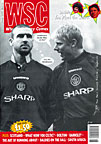 Cris Freddi looks at the history of the hairless footballer, and whether they are still around abroad
Cris Freddi looks at the history of the hairless footballer, and whether they are still around abroad
A bald fact: there weren’t many of them in the very early days of the game, partly because relatively few players won any caps after leaving university. Only when international careers grew longer did hairlines began to recede.
Two of them made up what amounted to a midfield partnership for England v Scotland in 1895: John Goodall and Jack Reynolds. Both sported obligatory Victorian moustaches and were balding from front to back, Goodall keeping the rest short, Reynolds leaving a carefree tuft over each ear. He was a fearsome tackler, Goodall the greatest playmaker of his generation, together a terrifying sight for any Scottish team. The 3-0 win was wrapped up by half-time.
The Italian team which won the 1938 World Cup featured another depilated pairing. The shrewd inside-forward Gioanin Ferrari, who’d also played in the 1934 final – and outside-right Amedeo Biavati, a forerunner of Lombardo, described as scarsocrinito (rough equivalent of ‘sparsely thatched’). Brought in after Italy’s wretched first match, his crosses and foot-over-the-ball feints completed the winning jigsaw.
Meanwhile other chrome domes who appeared in England shirts included beetle-browed Jock Rutherford, never on the losing side in eleven internationals (1904-08) and a dead ringer for Mervyn Peake’s drawings of Steerpike in Gormenghast; Jack Smith, who scored four goals in three matches (1931); polished full-back George Male (1934-39); and George ‘Lady’ Woodger (1911), whose looks didn’t match his nickname.
The most shining Welsh examples: Moses Russell (1912-28), who already looked like Methuselah in his early twenties and won his last cap at 40 – and classy, injury-prone Terry Hennessey (1962-72). Peter Taylor, Clough’s No 2 remembered “his bald head rising above our besieged defence in his greatest game,” Derby’s 0-0 draw away to Benfica.
Irishmen who won caps (and needed them) included Billy Gillespie, Tommy Breen and Johnny Carey, none of whom matched the high profile of Bill Gorman (1936-48), he of the ready smile and total lack of cranial cover. Imagine a pensioner grinning like a wicked kid. On second thoughts, don’t.
Later, Jeno Buzanszky was a distinctive figure in the great Hungarian side of the early Fifties. The only player with a provincial club, the one with the least skill and most skull. Uncannily similar in appearance (aren’t they all?), Viliam Schrojf had too many hairy moments in the 1962 World Cup final, at fault with all three Brazilian goals, but his shot-stopping had taken the Czechs there in the first place, eg his performance against Hungary in the quarter-final.
Czechoslovakia’s chances of going one better in 1966 foundered on a home defeat in the qualifiers by Portugal who confronted Schrojf with their captain Germano de Figueiredo, a late developer who became probably the greatest stopper of all time, Benfica’s one-man defence when they won the European Cup in 1961 and 1962. He even took over in goal against Inter in the 1965 final. Whereas Schrojf favoured a sort of lifted thatch at the back, in the style of the famous Ethiopian long distance runner, Miruts Yifter, Germano went in for the classic Sixties answer to baldness: prove you could grow hair elsewhere. Hence the most famous sideburns and moustache in Portuguese football.
Also plucked from the files: Mario Americo, Brazil’s black masseur and trainer when they won the 1958 & 1962 World Cups; Ferenc Bene, Hungary’s livewire winger in the 1966 tournament; Franck Leboeuf, who’s fooling no-one with that judicious use of the razor; and the great Gunnar Gren, who played for Sweden from 1940 to the 1958 World Cup final. The competition’s oldest goalscorer before Milla he was known as Il Professore when he played for Milan, and not just for his highbrow midfield play.
Others, too well-known to dwell on include Charlton, Coates, Mancini, Lechkov etc. Oh, and Italy gave caps to players called Baldo and Baldi, but both probably remained obstinately hirsute.
From WSC 124 June 1997. What was happening this month